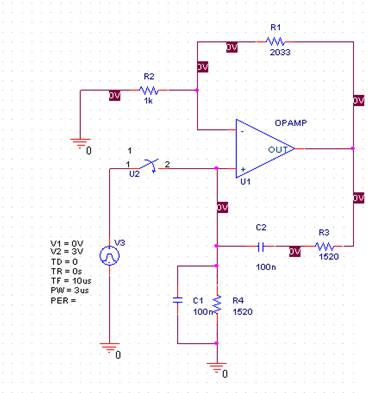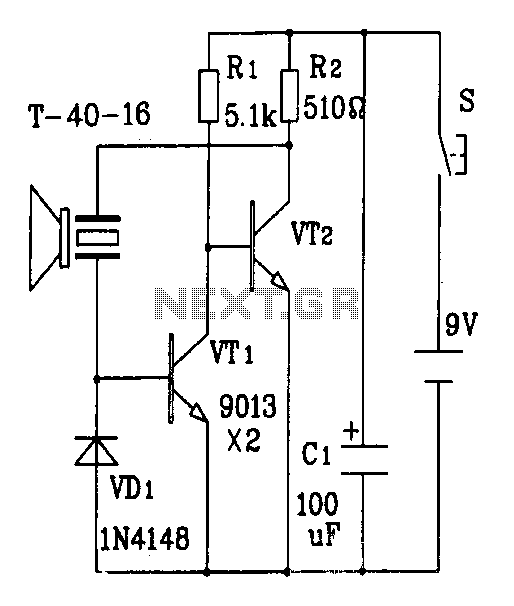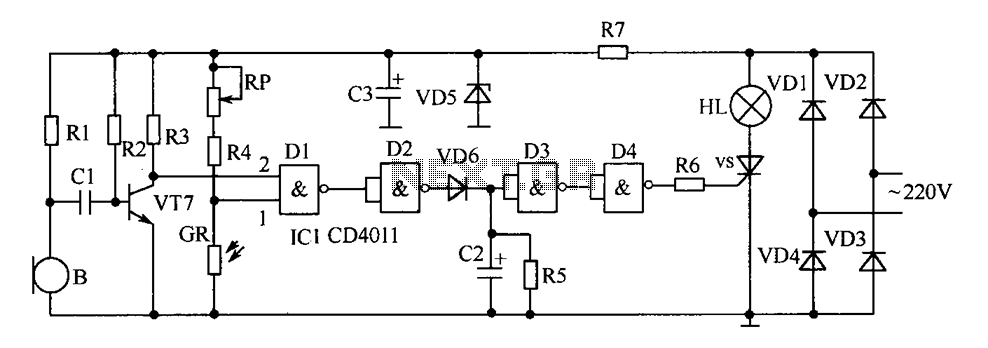
Wien bridge oscillator circuit

In this laboratory experiment, the objective is to design the frequency-determining network for a 1 kHz sinusoidal oscillator. The specified values are as follows: Capacitance = 100 nF and Resistance = 1520 ohms.
The output voltage waveform of the oscillator varies with changes in the value of R1. When R1 is set to 2033 ohms, the loop gain approaches 1, resulting in sustained oscillation. If R1 is adjusted to 2.1 k ohms, the loop gain exceeds 1, leading to overdamping of the oscillation. Conversely, setting R1 to 1.9 k ohms causes the loop gain to drop below 1, resulting in underdamping of the oscillation.
To design a 1 kHz sinusoidal oscillator, a frequency-determining network can be constructed using a combination of resistors and capacitors. The fundamental frequency (f) of the oscillator can be calculated using the formula:
\[ f = \frac{1}{2\pi R C} \]
Where:
- \( f \) is the frequency in Hertz (Hz),
- \( R \) is the resistance in ohms (Ω),
- \( C \) is the capacitance in farads (F).
Given the parameters of 100 nF for capacitance and the resistance value of 1520 ohms, the frequency can be verified as follows:
\[ f = \frac{1}{2\pi (1520)(100 \times 10^{-9})} \approx 1.05 \text{ kHz} \]
This indicates that adjustments to the resistance will be necessary to achieve the desired frequency of 1 kHz.
The oscillator's performance is sensitive to the feedback network, which is where R1 comes into play. By adjusting R1, the loop gain of the oscillator can be manipulated, affecting the stability and nature of the oscillation.
- When R1 is set to 2033 ohms, the loop gain is approximately 1, which is critical for maintaining stable oscillation. This is the ideal condition for the oscillator to function effectively without decay or excessive growth of the output signal.
- Increasing R1 to 2.1 k ohms results in a loop gain greater than 1, which introduces overdamping. In this scenario, the oscillator may struggle to produce a consistent waveform, leading to a slower response and potentially a damped oscillation that eventually settles at a steady state.
- Conversely, reducing R1 to 1.9 k ohms causes the loop gain to fall below 1, resulting in underdamped oscillation. This condition may cause the output waveform to exhibit ringing or oscillations that decay slowly, which may be undesirable for certain applications requiring a clean sinusoidal output.
In practical applications, careful selection of R1 in conjunction with the fixed resistance and capacitance values will allow the designer to achieve the desired oscillation characteristics for specific circuit requirements.In this laboratory experiment, we need to design the frequency determining network for a 1k Hz sinusoidal oscillator. Therefore, we should set: Capacitance = 100nF Resistance = 1520 ohm
The output voltage waveform of the oscillator varies with changes in the value of R1. When R1 is set to 2033 ohms, the loop gain approaches 1, resulting in sustained oscillation. If R1 is adjusted to 2.1 k ohms, the loop gain exceeds 1, leading to overdamping of the oscillation. Conversely, setting R1 to 1.9 k ohms causes the loop gain to drop below 1, resulting in underdamping of the oscillation.
To design a 1 kHz sinusoidal oscillator, a frequency-determining network can be constructed using a combination of resistors and capacitors. The fundamental frequency (f) of the oscillator can be calculated using the formula:
\[ f = \frac{1}{2\pi R C} \]
Where:
- \( f \) is the frequency in Hertz (Hz),
- \( R \) is the resistance in ohms (Ω),
- \( C \) is the capacitance in farads (F).
Given the parameters of 100 nF for capacitance and the resistance value of 1520 ohms, the frequency can be verified as follows:
\[ f = \frac{1}{2\pi (1520)(100 \times 10^{-9})} \approx 1.05 \text{ kHz} \]
This indicates that adjustments to the resistance will be necessary to achieve the desired frequency of 1 kHz.
The oscillator's performance is sensitive to the feedback network, which is where R1 comes into play. By adjusting R1, the loop gain of the oscillator can be manipulated, affecting the stability and nature of the oscillation.
- When R1 is set to 2033 ohms, the loop gain is approximately 1, which is critical for maintaining stable oscillation. This is the ideal condition for the oscillator to function effectively without decay or excessive growth of the output signal.
- Increasing R1 to 2.1 k ohms results in a loop gain greater than 1, which introduces overdamping. In this scenario, the oscillator may struggle to produce a consistent waveform, leading to a slower response and potentially a damped oscillation that eventually settles at a steady state.
- Conversely, reducing R1 to 1.9 k ohms causes the loop gain to fall below 1, resulting in underdamped oscillation. This condition may cause the output waveform to exhibit ringing or oscillations that decay slowly, which may be undesirable for certain applications requiring a clean sinusoidal output.
In practical applications, careful selection of R1 in conjunction with the fixed resistance and capacitance values will allow the designer to achieve the desired oscillation characteristics for specific circuit requirements.In this laboratory experiment, we need to design the frequency determining network for a 1k Hz sinusoidal oscillator. Therefore, we should set: Capacitance = 100nF Resistance = 1520 ohm
Output voltage waveform of oscillator with varying the value of R1:
Set R1 = 2033 ohm (The loop gain is about to 1, sustained oscillation is resulted.)
Ser R1=2.1k ohm (The loop gain is greater than 1, overdamping oscillation is resulted.)
Set R1= 1.9k ohm (The loop gain is smaller than 1, underdamping oscillation is resulted.)
🔗 External reference




